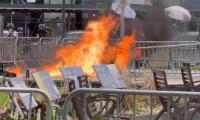In Pakistan motorcycles are an increasingly common and most popular mode of transport primarily owing to its affordable price. These motorbikes including three wheelers share more than 50% of registered vehicles in Pakistan. Roving along with other vehicle on the same road, dispense the bikers more vulnerable. Unlike other vulnerable road users e.g. pedestrians and pedal cyclists, the motorcyclists travel at high speed with low reflectivity to associated commuters. Lamentably, our motorcycle riders have high risk thresholds, low education, no regular bike training and lack of experience; all these affect their behaviuor and contribute towards making them most vulnerable road users. Travelling without any physical protection, the riders get severe injuries if involve in road collision. World Health Organisation (WHO) reports that motorcyclists comprise one-third of all road traffic deaths in South Asia. Another study revealed that motorcycles are involved in 21% of road traffic accidents in Pakistan but owing to their vulnerability they share 34% of total road deaths toll. Injuries to the head and neck are the main cause of death and disability among victims of motorcycle crashes. Careless attitude of riders also pose a serious danger to other road users.
Motorcyclists are highly susceptible to accidents. Collisions encompass motorcycles are most severe among all kinds of vehicle crashes. Owing to devoid of any protective shield around them, motorcyclists are highly insecure in case of an accident. Because majority of victims of motorcycle crashes are young, mostly bread winners of their families, these crashes cost high socio-economic impacts on low income countries like Pakistan. WHO reports that road accidents are leading cause of death among 16-45 years age group of people; among them mostly are motorcycle riders.
In Pakistan more than 80% of motorcyclists’ fatalities are attributed to head injuries. Use of safety helmet while riding is the most effective measure to mitigate magnitude of such injuries. Wearing a good quality helmet can reduce the risk of death and severe injuries by 40% and 70%, respectively in road collisions. Wearing of Safety helmet while riding is mandatory by law in Pakistan but this safety gadget is neither accepted nor practiced by two wheelers in true letter and spirit. Aggressive safety helmet awareness campaigns using all communication means followed by intelligent enforcement regarding mandatory use of helmet can prove effective strategies to change the mindset of motorcyclists in our beloved homeland.
Unavailability of well aerated and user friendly safety helmet enhances the non-wearing rates especially in summer. Provision of a quality helmet can improve the wearing percentage. Substandard safety helmets have invaded the market due to absence of safety protocol which deal the aerodynamics and manufacturing of safety helmet. The quality of safety helmet is a big concern which needs special attention of authorities concerned.
Riding by underage riders is another cause of accidents in Pakistan. Distinctive counseling of parents and elders can be an effective measure to check this malpractice.
Pre-license training for riders is mandatory in many countries of the globe. This proactive paradigm is very weak in Pakistan not only for bikers but for drivers of other vehicles as well. That is why drivers generally and motorcyclists specifically do not keep basic knowledge of traffic law and road safety procedures. Most riders travel with self-improvised thought that they are not within the purview of traffic laws and such guidelines are documented to regulate four wheelers only. Lane violation, team riding, one way violation, over speeding, overloading, improper loading and wrong turns are paramount examples of traffic violation which are committed by riders deliberately.
Sometime motorcycle accidents are rear-enders, so it’s a pretty good idea to make sure your mirrors are not only fitted but also adjusted properly. But in Pakistan, the rear view mirrors are removed soon after the purchase of new motorbike. This careless act leaves the bikers highly susceptible to accident with rearward traffic. Without back view mirrors the bikers remain unaware with ever-changing situation on the road and often become the victim of rearward traffic while taking right turn or sudden lane change. Riding without back view mirror is not taken a gross violation by traffic managing authorities in Pakistan.
One wheeling has emerged as newfangled dangerous phenomenon in recent years. This precarious feat is engulfing young riders across the country. In the absence of a fair managing strategy the, teenagers are getting more and more fascination towards wheelie.
Punjab government has introduced special law to curb this fatal behaviour. This law needs to be adopted and enforced vigorously by Islamabad and other provinces to show commitment as nation to end this perilous adventure of one-wheeling.
Hasty attitude of riders is another eye-catching factor causing accidents on the roads. Every third accident of motorcycles is attributed by over speeding. Moreover, the over speed surges the collision impact of motorcycle manifold. Riders try to take a short cut by moving on wrong side of road or overtaking from left. Motorcyclists assume that they will pass through small fissures due to their miniature size as compared to other vehicle but the scene changes rapidly on road and they fall prey owing to their misjudgment. Use of indicators to show rider’s intention to following traffic is out of practice which becomes the principal reason of motorcycles rearward collision at U-turns or while changing lanes.
The girls and women pillion riders position themselves on bike with both legs toward one side. This erroneous and dangerous but artistically adopted sitting posture leave female pillion riders highly susceptible to deadly motorcycle collisions. They fell down and get injured seriously on small bumps, sudden drift, minor imbalance or abrupt pacing. Unwrapped and loose cloths of female pillion riders get entangled in rear wheel lead to fatal accidents. Motorcycle is designed for two persons only but overloading is a common practice. This overloading weakens the rider’s control over bike leaving it more vulnerable.
Being seen and being perceived correctly and accurately to other road users are extremely important factors to minimise crashes of motorcyclists. Conspicuity for both bike and biker is of utmost importance. Use of day time running motorcycle lights is a proved intervention exercised in many countries. This law proved helpful in reducing more than 20% motorcycle accidents in countries where it was implemented. Suitable motorcycle oriented clothing will not only increase the visibility of riders but also reduces the risk of sustaining abrasions, lacerations and the intensity of injuries.
The safety of powered two wheelers is always challenging and complex. Often problems stem from human error either by the rider or other driver resulting in a conflict because there is no enough time for the rider/driver to avoid the collision whatever the level of skills they keep. Proper training of Collision Avoidance Techniques can help to reduce the magnitude of collision. Some other conflicts are due to a failure of driver of other vehicles to see and correctly perceive the motorbike and actions of its riders prior to the impact.
Albeit the riders’ failure is a primary cause of their road crashes but the road conditions and chaotic traffic environment cannot be ignored. The frequency of accident occurrence on urban roads is much higher as compared to roads in rural areas. Road engineering shortcomings (blind corners, uneven surface, pothole, loose gravel and low friction) are other superfluous causes of motorcycles crashes.
Inclement weather conditions also affect the smooth operation of two wheelers. A good rider with proactive mindset can definitely avoid traffic collisions under these adverse situations.
Motorcycle safety can be increased with the separation of two wheeled motorcycles from other high-speed vehicles. This segregation can take one of two forms. Exclusive motorcycle lanes can be created on roads as constructed in Malaysia and some other countries. These exclusive motorcycle lanes are separated from the carriageway by a physical crash barrier; or a joint motorcycle, three wheelers and non motorised vehicles lanes can be provided, as in Vietnam. These established road engineering interventions are equally applicable in Pakistan. Authorities have to give attention to improve safety of careless motorised two wheelers.
The writer is road safety expert and senior patrol officer at NH&MP.
Saad was of the view that the battle of politics should be fought solely through political means
KP govt decided to develop gemstone business as a formal export sector and cluster at the Namak Mandi would be...
Khyber Pakhtunkhwa Minister for Higher Education, Archives, and Libraries, Meena Khan Afridi. — APP FilePESHAWAR:...
Vehicles and horse carts passing through flood water at Bara Bazar area on Khuwani bridge after heavy rain in Peshawar...
Amid the failure to revive the cash-bleeding PIA, government is left with no other option but to sell it to any...
Picture showing the Silver Jubilee Gate of the University of Karachi. — APP File KARACHI: The University of Karachi...







